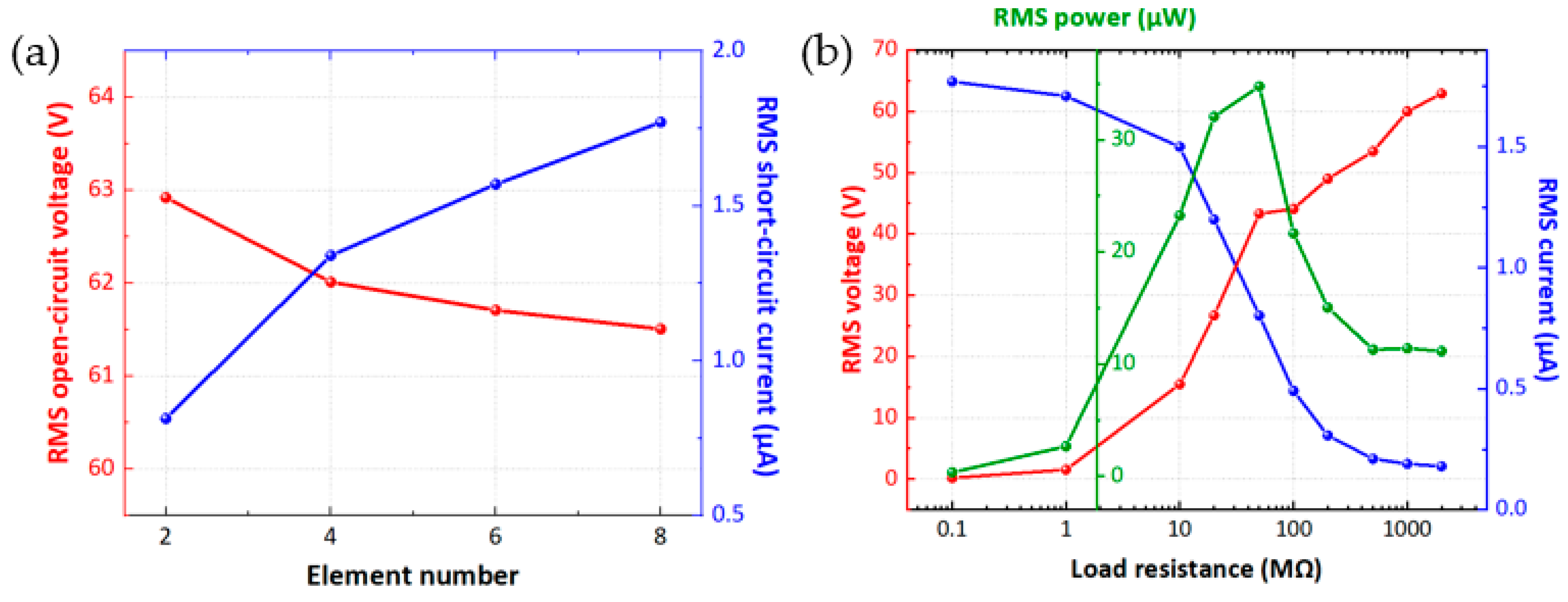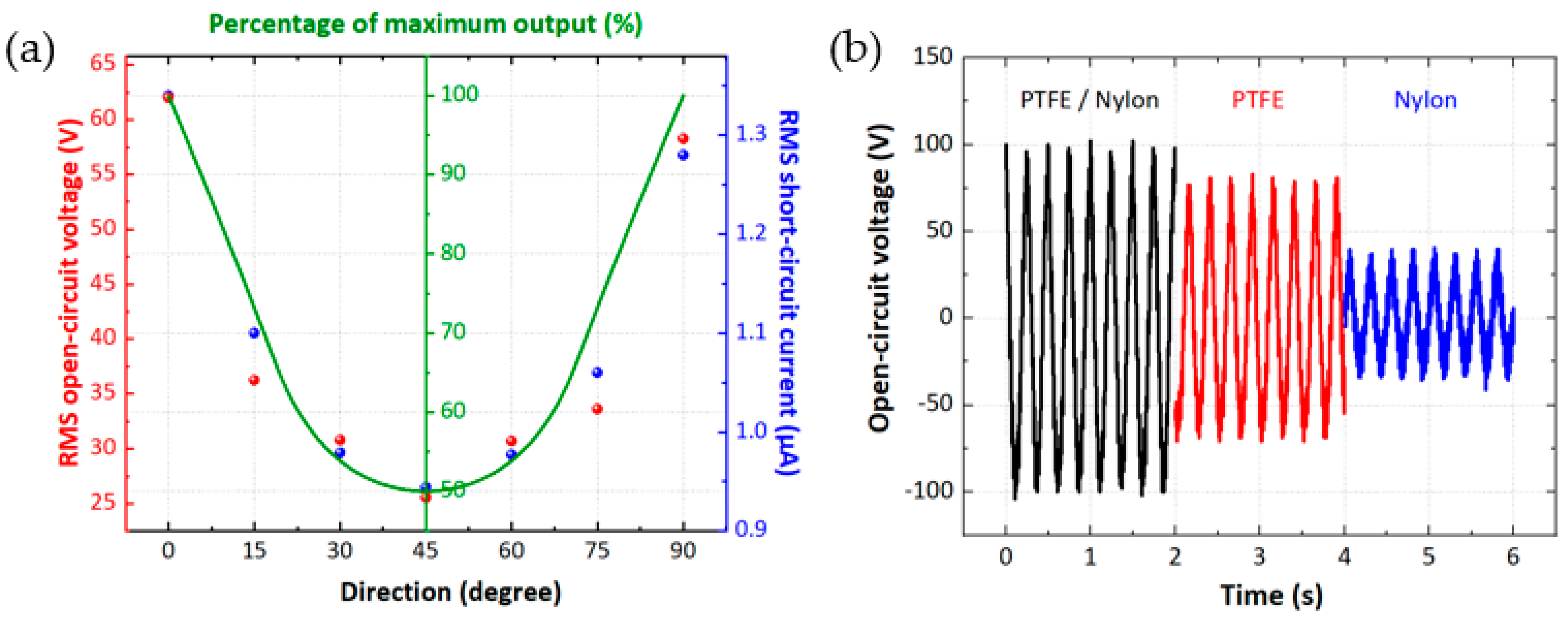1. Introduction
Despite intensive research and development in wearable and portable electronics, most of these types of devices are still powered by batteries, which require persistent recharging and replacement. Introducing a wearable self-charging power system using an energy harvester to scavenge energy from human body movements is one of the most effective ways to solve this problem. The triboelectric nanogenerator (TENG) is one of the most promising candidates for powering these devices. They can efficiently convert kinetic energy occurring after or during frictional contact between two dissimilar materials into electricity based on contact electrification and electrostatic induction effects [
1]. They are determined to be highly suitable for powering wearable devices and electronic textiles (e-textiles) due to their properties, including low weight, flexibility, washability, high efficiency, and biocompatibility [
2,
3,
4].
This paper proposes a novel structure of textile-based TENG with alternate woven strips of positive and negative triboelectric material operating in sliding freestanding triboelectric-layer mode, defined as a woven TENG. They can harvest energy from all arbitrary sliding directions. Whereas most of the TENGs with this ability are made of rigid materials and thus unsuitable for e-textiles [
5,
6,
7], this woven TENG is fabricated using processes which are compatible with standard textile manufacturing, including plain weaving and doctor blading. Moreover, the introduction of the positive and negative triboelectric material considerably enhances the power output of the device.
2. Device and Working Principle
The device is composed of a woven upper substrate and woven electrodes, as shown in
Figure 1a. The photograph of the upper substrate is illustrated in
Figure 1b. It is fabricated by plain-weaving strips of adhesive nylon fabric (Hemline) and PTFE-coated fibreglass fabric (Xinghoo) forming a checker-like structure. The adhesive layer on the back side of the nylon fabric and the PTFE coating layer bond their fibers together and prevent the fabrics from fraying when they are cut into strips. The nylon fabric and the PTFE fabric were selected as the positive triboelectric material and the negative triboelectric material since they are some of the most positive and negative materials in the triboelectric series, respectively. Additionally, they are available in a commercial fabric form and have good properties for implementation in wearable devices, such as flexibility, lightweight, biocompatibility, and washability.
The photograph of the lower electrodes is illustrated in
Figure 1c. It was fabricated by doctor blade coating Ag ink (Fabinks TC-C4001) on a PVC-coated polyester fabric, defined as PVC fabric (VALMEX FR 7546). Two pieces of PVC fabric were firstly pre-baked at 120 °C for 15 min in a Carbolite box oven to eliminate outgassing from the PVC layer. After that, a doctor blade was used to coat the PVC fabric with a 100 µm-thick Ag ink, and was cured at a temperature of 120 °C for 15 min. The Ag-coated PVC fabrics were then cut into strips of the same size with a 1 mm gap between each strip, leaving one end uncut. Finally, the two Ag-coated PVC fabrics were woven together, forming the lower woven electrodes. The uncut ends enable the warp strips and weft strips to be electrically connected forming separate warp and weft electrodes. The 1 mm gap ensures that the warp and weft electrode are electrically isolated after weaving. The upper substrate and the electrodes were produced with various numbers of elements (
N) on each side with
N equalling 2, 4, 6, and 8 with strip widths of 4 cm, 2 cm, 1.33 cm, and 1 cm, respectively. The total size of the upper substrate was fixed at 8 cm × 8 cm. Alternatively, the electrodes can be fabricated by attaching pre-cut adhesive vinyl stencil strips with a width of 1 mm to the PVC fabric before doctor-blading it with Ag ink. After removing the vinyl stencil strips, the 1 mm uncoated gaps were formed between the electrode strips. The advantage of this method is that it can prevent the electrodes from electrical short circuits.
With regards to the Ag electrodes, when the positive (nylon fabric) and negative triboelectric materials (PTFE fabric) are brought into contact with the Ag electrodes, positive and negative charges build up at their surface, respectively, and at the same time, the same amount of charge with the opposite polarity can be transferred to the electrodes due to the triboelectric effect. Through a sliding movement of the woven triboelectric materials across the woven electrodes, the electrons were induced and transferred between the weft and the warp electrode due to the potential difference at the electrodes caused by the shielding effect and the difference in distance between the triboelectric materials and the top and bottom electrode. Through this periodic movement, multiple alternating currents were generated.
3. Experimental Results
The experiments were performed using a belt-driven linear actuator at a mechanical oscillation of 2 Hz, a travel distance of 40 mm, a contact force of 5 N, a humidity of 25% RH, and a temperature of 25 °C.
Figure 2a shows the root mean square (RMS) values of the open-circuit voltage (
VOC) and the short-circuit current (
ISC) of the woven TENG for the different element numbers. The
VOC slightly decreases as the element number increases due to a growth in the capacitance of the electrodes with smaller strips, whereas the
ISC shows a strong increasing trend due to a reduction in the travel time of the charge transfer. The dependence of the RMS voltage, RMS current, and RMS power on the external load resistance of the woven TENG with
N = 8 is revealed in
Figure 2b. The RMS voltage and RMS current peak at 62.9 V and 1.77 µA, respectively. The RMS power reaches a maximum of 34.77 µW at a load resistance of 50 MΩ, corresponding to a maximum power density of 5.43 mW/m
2.
The experimental RMS
VOC and RMS
ISC, as functions of the sliding direction with respect to the weft electrode alignment, are plotted in
Figure 3a. They are compared with the percentage of the maximum output calculated from the ratio of the overlapping areas between the upper substrate and the electrodes at each sliding direction. The maximum outputs are obtained when the upper substrate slides are parallel or perpendicular to the weft electrode, and the minimum outputs of 50% of the maximum outputs are produced when the upper substrate moves diagonally with respect to the weft electrode (45 degrees).
Figure 3b shows the transient
VOC for the woven TENG with PTFE and nylon fabric (
N = 4), a checker-like structured TENG with PTFE fabric and a checker-like structured TENG with nylon fabric. The
VOC of the woven TENG rises by 1.3 times and 2.6 times compared to the TENG with only PTFE fabric and nylon fabric, respectively.
To demonstrate a possible use of the woven TENG in wearable electronics, the woven TENG (
N = 8) was embedded into a lab coat. The energy is generated from the relative movement between the arm and the torso during walking and running. The output of the woven TENG was used to charge capacitors with different capacitances. The capacitors can be charged to a useful voltage for wearable electronics in a short period. For example, it takes 4 s and 15 s to charge a 1 µF capacitor to 3 V for running and walking, respectively. The output was also used to drive a wearable night-time warning indicator for pedestrians (
Figure 4a), a digital watch (
Figure 4b), and a Bluetooth transceiver. As a demonstration of a sensing device (
Figure 4c), the voltage peaks of the woven TENG was detected and applied for step counting through arm motion (pedometer). Additionally, the device also shows good washability and durability. It can withstand 40,000 operating cycles and 5 washes without significant change in the output.
4. Conclusions
A novel textile-based triboelectric generator was successfully fabricated using processes that are compatible with standard textile manufacturing, including plain weaving and doctor blade coating, defined as woven TENG. The woven TENG comprises a woven upper substrate with alternating positive (nylon fabric) and negative triboelectric material (PTFE fabric) and woven Ag electrodes with matching structure. The woven TENG can generate energy in all sliding directions, demonstrating the significant performance improvement compared to the TENGs with single triboelectric materials. This paper has demonstrated the applications for the woven TENG, including a wearable night-time warning indicator, a digital watch, a Bluetooth transceiver, and a pedometer.
Author Contributions
Conceptualization, methodology, writing, editing W.P.; applications, W.P. and M.W.; supervision, R.T. and S.B. All authors have read and agreed to the published version of the manuscript.
Funding
This research was funded by the Engineering and Physical Sciences Research Council (EPSRC) with grant reference EP/P010164/1.
Institutional Review Board Statement
Not applicable.
Informed Consent Statement
Not applicable.
Data Availability Statement
Not applicable.
Conflicts of Interest
The authors declare no conflict of interest. The funders had no role in the design of the study; in the collection, analyses, or interpretation of data; in the writing of the manuscript, or in the decision to publish the results.
References
- Fan, F.-R.; Tian, Z.-Q.; Lin Wang, Z. Flexible triboelectric generator. Nano Energy 2012, 1, 328–334. [Google Scholar] [CrossRef]
- Paosangthong, W.; Torah, R.; Beeby, S. Recent progress on textile-based triboelectric nanogenerators. Nano Energy 2019, 55, 401–423. [Google Scholar] [CrossRef] [Green Version]
- Paosangthong, W.; Wagih, M.; Torah, R.; Beeby, S. Textile Manufacturing Compatible Triboelectric Nanogenerator with Alternating Positive and Negative Freestanding Grating Structure. Proceedings 2020, 32, 23. [Google Scholar]
- Paosangthong, W.; Wagih, M.; Torah, R.; Beeby, S. Textile-based triboelectric nanogenerator with alternating positive and negative freestanding grating structure. Nano Energy 2019, 66, 104148. [Google Scholar] [CrossRef]
- Guo, H.; Leng, Q.; He, X.; Wang, M.; Chen, J.; Hu, C.; Xi, Y. A triboelectric generator based on checker-like interdigital electrodes with a sandwiched PET thin film for harvesting sliding energy in all directions. Adv. Energy Mater. 2015, 5, 1400790. [Google Scholar] [CrossRef]
- Li, X.; Xu, C.; Wang, C.; Shao, J.; Chen, X.; Wang, C.; Tian, H.; Wang, Y.; Yang, Q.; Wang, L.; et al. Improved triboelectrification effect by bendable and slidable fish-scale-like microstructures. Nano Energy 2017, 40, 646–654. [Google Scholar] [CrossRef]
- Xia, X.; Liu, G.; Guo, H.; Leng, Q.; Hu, C.; Xi, Y. Honeycomb-like three electrodes based triboelectric generator for harvesting energy in full space and as a self-powered vibration alertor. Nano Energy 2015, 15, 766–775. [Google Scholar] [CrossRef]
| Publisher’s Note: MDPI stays neutral with regard to jurisdictional claims in published maps and institutional affiliations. |
© 2022 by the authors. Licensee MDPI, Basel, Switzerland. This article is an open access article distributed under the terms and conditions of the Creative Commons Attribution (CC BY) license (https://creativecommons.org/licenses/by/4.0/).












